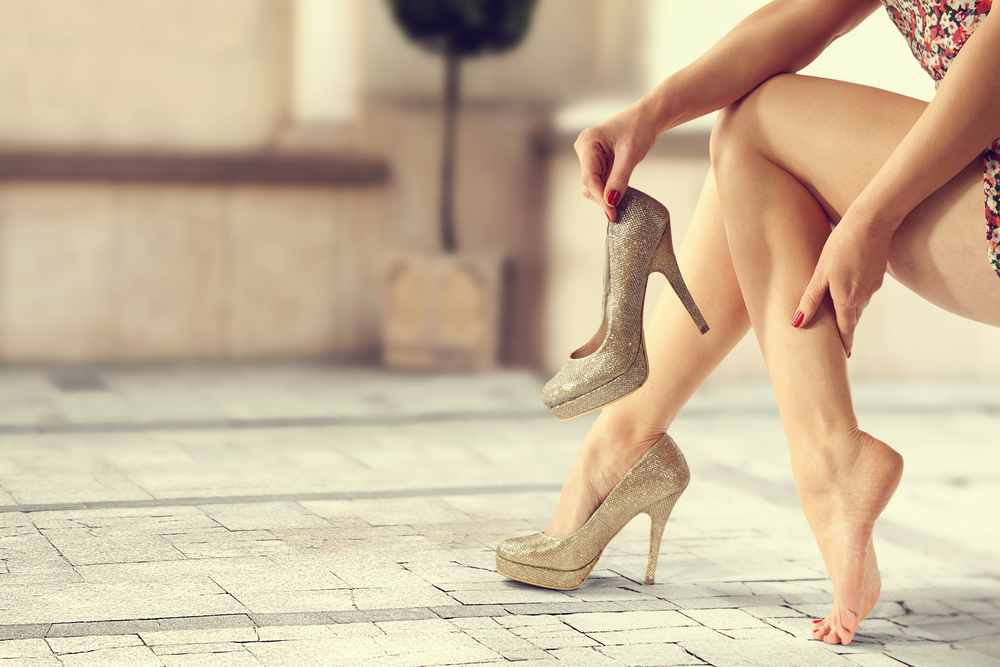High heels have the disgrace of being distressing for health and comfort, but this hardly stops women from wearing them occasionally and a lot regularly. Here’s why you should really give up on those killer heels.
Women know the struggle of wearing stilettos. They know how painful they can be. Even though opting for comfortable footwear is trendy these days, many women still choose to wear these killer heels, whether on special occasions or every day. But high heels can land your body into some serious problems. Your feet are the base of your body. They help you move and maintain your posture as well. Thus, wearing high heels can affect your entire skeleton. Heels shift your entire body weight towards the balls of your feet making your knees and hips fall slightly forward and thus, your back has to hyperextend in the backward direction in order to maintain balance.

1. Feet:
Basically, heels don’t allow your foot to function properly. Wearing heels can cause serious joint diseases in your foot.
2. Achilles Tendon:
High heels can stunt your growth and stiffen the muscle-tendon unit that connects your ankle to your calf muscle, if worn on a daily basis. Eventually, you will find it difficult to stretch your legs and walk even when you are bare feet.
Also Read: Guide to Good Personal Hygiene
3. Knees:
When you wear heels the weight of your body shifts towards the ball of your foot. In return, your knees have to move forward to maintain the balance of your body. This puts an extra stress on your knees.
4. Hips
Wearing heels also puts a stress on your hips making them move forward to balance the extra pressure on the balls of your feet. This can give you a severe pain in your butts and areas including your inner thighs and groin after indulging in any type of leg movement.
5. Back:
One of the reasons which makes high heels women’s favorite is that wearing heels make their butt look great. This is due to the fact that while your hips and knees move forward to balance out the extra weight in the balls of your feet, your lower back hyperextends backward. This might make you look great, however, wearing heels on a daily basis can be really dangerous for your back and can lead to complications like back spasms, chronic back soreness, and eventually arthritis.
4 Ways to lessen the Damage:
There’s no doubt that heels make you look awesome, however, they can give rise to some serious health issues. But if you still can’t do without heels, just keep in mind these smarter ways to wear them.
1. Wear lower heels or wedges.
As you probably guessed, higher heels are worse for your feet. Taller shoes make you shift your weight even more, which can lead to torn ligaments and stress fractures. Wearing wedges or heels that are two inches or less is a better deal. Wedges still aren’t great for your feet, but the platform reduces the incline, helping you balance and lessening the pressure on the ball of your foot.
2. Opt for a wider toe.
Wide as opposed to narrow-toed heels are also a better bet. A narrower shoe can cause a pinching of the nerves between the bones in the ball of your foot.
3. Change the height of the heel you wear from day to day.
Frequent wearers should switch between different heel heights. There is a possibility that of the Achilles tendon to contract on wearing heels of the same height every day consistently. However, by regularly switching, the tendon is allowed to stretch and is kept from damage.
Also Read: The health benefits of water
4. Cap the time you’re walking in heels to three hours at a time.
You may have already tried this trick: Wear flats to work or an event and switch to heels when you arrive. But it’s still a good idea to pay attention to how long you’re walking in them. For strutting your stuff, a good general cutoff is to keep your heels on for no more than three hours.
Conclusion:
You can acquire a multitude of foot problems from high heels. One of the most dreadful effects of wearing high heels is shortened Achilles Tendon. So, avoid high heels and switch to healthier alternatives.




